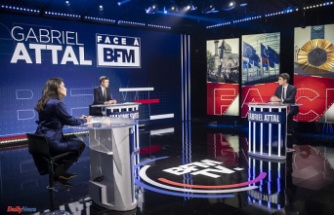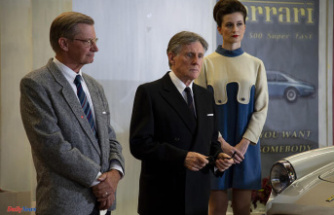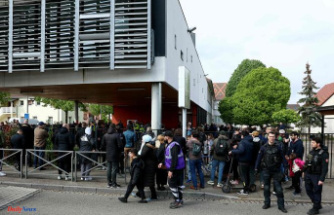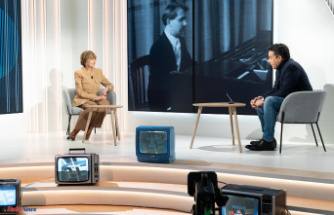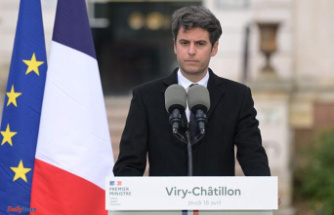They had to witness terrible crimes: Four children who survived the Holocaust. The book "But I live" tells their stories as a comic. Illustrator Barbara Yelin sees this as an opportunity to "open doors to new generations" before there are no longer any contemporary witnesses.
"Freedom is not a gift from heaven," says David Schaffer. "You have to fight for it every day. Please keep that in mind!" It is a moving moment when the over 90-year-old shares these thoughts with the audience at the Comic Salon in Erlangen in June. Schaffer, who is video streaming from Vancouver, has just spoken about a book that tells his story and that of three other people who survived the Holocaust as children and that is now being published in German by Beck: "But I'm alive ! Four children survive the Holocaust".
The special thing about it is the approach: the life stories are artistically processed, but remain close to the historical facts thanks to scientific help. The German illustrator Barbara Yelin tells the story of Emmie Arbel, who survived several concentration camps, including Ravensbrück and Bergen-Belsen. The American-Israeli illustrator Miriam Libicki describes the life of Schaffer, who was deported to Transnistria with his family. Finally, in his story, the Israeli artist Gilad Seliktar follows the path of Nico and Rolf Kamp, who were able to survive the Holocaust in a total of 13 hiding places in the Netherlands.
It's a mammoth project that the three artists are tackling - and that's only possible because the book is backed by an international network of artists, researchers and institutions such as concentration camp memorials, which have their say in the extensive appendix. An exhibition in the Erlangen City Museum, which can be seen until the end of August, also provides an insight into the history of the book's origins. The project called Narrative Art
"The project is about putting Holocaust survivors in a dialogue with graphic novelists and telling their stories before the last generation of contemporary witnesses dies," says Yelin in an interview with ntv.de about the starting point of the book. There is a turning point, according to Yelin, "because there will be generations who will no longer be able to speak to survivors of the Holocaust or direct contemporary witnesses." The graphic novel can be a way of telling the events in a very special way and "opening doors to new generations with these stories".
Emmie Arbel was initially skeptical about comics as an art form. But she dropped it after a preliminary talk. Finally, just before the start of the corona pandemic, Yelin traveled to Israel and spent several days with the Holocaust survivors. Arbel told her story not for the first time. For years she has appeared in front of people and enlightened them about the Holocaust - a tremendous feat. "It's only now that I understand what that means," says Yelin. "Repeating the worst, traumatic memories over and over again, each time in front of an audience that may not be particularly knowledgeable, and allowing for questions that keep coming back to you." The eyewitnesses would see this as an order: "They want to change the future so that it never happens again," explains Yelin.
The strength of the book is that it doesn't just retell the experiences of the survivors, but focuses on the people behind the biographies. Yelin, for example, does not reduce Arbel to her memories, but shows her entire personality. Again and again the story jumps between Arbel's memories of the concentration camps and her present in Israel, surrounded by children and grandchildren. Yelin shows the strengths of comics here: she superimposes both time levels, connecting them with speech bubbles or captions. Next to the little girl in the concentration camp who has her hair shaved is the old woman who looks at herself in the mirror and who almost cried when one of her daughters cut her hair very short.
The conclusion that emerges, and which the other two artists also take up, is oppressive: the memories are not part of the past, they are part of the everyday life of the survivors, every day anew, even across generations - an aspect that Art Spiegelman already explored his groundbreaking Holocaust comic "Maus". "For me, working with Emmie made what happened back then very tangible," says Yelin. "Of course, learning about history is also important, such as dates or political developments. But it is possible to understand what these events mean in concrete terms through such stories and personalities," she says. Sentences like "Death was very familiar to us" by Arbel resonate for a long time when reading.
The constant juxtaposition of past and present, held together by the protagonist, makes the contribution about Emmie Arbel the most narratively complex in the volume. However, all three stories have their strengths, which they draw from their different artistic approaches.
"You can't forget it. It won't let you go and it wears you down," says David Schaffer in his story about the haunting memory of impending annihilation. He too looks in a mirror and sees his younger self: Schaffer was deported with his family to Transnistria in 1940 by Romanian troops allied with Germany. They were not sent to concentration camps but were abandoned in the inhospitable area to die. Only those who violated the strict rules at the risk of their lives and left the assigned area in search of food could survive like Schaffer. It is a chapter of the Holocaust that is little known in Germany.
The story told by the artist Miriam Libicki impresses with its visual ideas and colourfulness. While Yelin, as in "Irmina", focuses primarily on dark blue tones, which are only occasionally brightened by the Israeli sun, Libicki primarily uses red tones and the green of the forests in which Schaffer hides. Together with their rather thick lines, their pictures appear like colored pencil drawings. But there is no lightness here: the misery of the people is shown, the brutality of the Romanian troops, the constant fear of death on their faces. There are also representations reminiscent of technical diagrams - a reminiscence of the engineer Schaffer.
Gilad Seliktar tells his story about the brothers Rolf and Nico Kamp, who appear again and again as contemporary witnesses who are asked about their memories. Seliktar's drawings were created on the computer, they are very reduced and leave a lot of open space. Blue-grey and beige determine the color scheme, but there is always a harsh, black line that penetrates violently into the pictures. He is like the impending danger that constantly looms over the young brothers, causing them to flee from hiding place to hiding place. The two survive the Holocaust at a total of 13 locations, mostly farms in the Netherlands.
As with Libicki, the landscape also plays an important role in Seliktar. Forests and meadows serve as hiding places, nature is a haven from the horrors of so-called civilization, but danger is always present. The draftsman's often sketchy style illustrates this well: Little is concrete, little sticks because the next escape is imminent. But it also reflects the fragility of memories - which often consist of schemes, of specific details, not of the big, all-encompassing picture. At a notable point in the story, Seliktar juxtaposes the portrayal of the two brothers, each of whom remembers an event differently.
Gaps in memory also play a role in the story about Emmie Arbel. "I don't remember," she keeps saying. Yelin then worked with various means, deliberately leaving the drawings unclear and blurry. However, the project team was also able to close some gaps. Arbel does not remember exactly what happened in Bergen-Belsen after the liberation, when her mother died exhausted. However, the time can be reconstructed through file entries that the team researched.
Where memories fade, it's good to hold onto them. As in this book, especially because it draws on the often neglected perspective of the victims. Although there is footage from concentration camps, for example, it almost always comes from the hands of perpetrators. "But the perspective of the detainees - how should they have been photographed?" Yelin asks. Much is archived or documented by the meticulous archives of the Nazis. "But the visual perspective of the persecuted, beyond the eyewitness archives, is not that common."
Of course, the book "But I live" cannot bring back what was lost, but it can approach it. The close exchange with the survivors is particularly important because it will not be long before the last eyewitnesses to the Holocaust have died. The book keeps their memories alive. The juxtaposition of artistic approach and historical accuracy offers a new approach that should set standards - the Narrative Art project
On Thursday, July 21, Barbara Yelin will present the book at the Dachau City Library.


